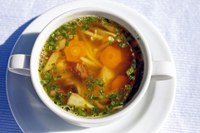Prairie Fare: Consider Virtual Family Meals
(Click an image below to view a high-resolution image that can be downloaded)
By Julie Garden-Robinson, Food and Nutrition Specialist
NDSU Extension
The other day I was wrapping my collection of snowman salt and pepper shakers.
Yes, my snowmen witnessed the spring and summer seasons of 2020.
In some ways, time has stood still during our pandemic.
After eight months of navigating our strange time in history, I decided to get in the spirit of upcoming holidays. I put out my pumpkins, scarecrows and a couple of turkey decorations for Thanksgiving.
I filled 24 orange jack-o’-lantern plastic bags with leaves and lined them up in front of our house. Unfortunately, some of the 5-year-old bags look more like squash bags because they have faded to a sickly green. My husband and I tend to reuse things.
Besides, every store we visited was sold out of new jack-o’-lantern bags.
Then it snowed in October. My pumpkin bags looked like nauseous snowman heads peeking from under a snowbank. Snowmen were haunting me.
The upcoming holiday season may be different for many families for various reasons. Fewer people are traveling to visit family members.
How do you navigate our “new normal” that seems abnormal?
Fortunately, we have many ways to connect, and food can bring people together. Perhaps a silver lining of the pandemic is the increased number of people cooking and dining together at home.
Family meals engage our senses, including sight, touch, taste, smell and hearing, as we enjoy food and laugh together.
Nutritionally, family meals make a difference. According to researchers, meals eaten with family members include less fat, less soda pop and more fruits and vegetables. Family meals also tend to be higher in calcium, fiber and other essential nutrients. Children who eat balanced meals with their families are less likely to become overweight.
Children who eat more meals with their families are more likely to earn mostly A's and B’s, compared with kids who eat fewer times with their families. Children who eat with their families improve their communication skills and build their vocabularies.
What if we cannot be together in person for various reasons?
Maybe we need to gather outside a window with glass between us and phones in hand.
We also can gather in electronic ways, such as through the now-familiar-to-most Zoom online platform. You can be your own “Brady bunch” on a screen. Or maybe FaceBook Live, Skype or a speaker phone works for you.
Plan a fun and memorable gathering. Consider a virtual dinner party with a theme.
A virtual dinner party doesn’t have to be fancy, but it can be creative. How about a “make your own” pizza virtual dinner party? Maybe the family “gourmet” can provide easy recipes and a grocery list ahead of time. Perhaps guests can do a live demonstration of making an easy appetizer or dessert.
Provide conversation starters for your guests: What were the popular TV shows when you were young? What was the best gift you ever gave or received?
We have resources and programs through NDSU Extension that encourage the practice of family mealtimes. See https://www.ag.ndsu.edu/familytable to sign up for the free monthly e-newsletter and our Facebook page that provides regular ideas. We also have an abundance of conversation starters.
For the next couple of columns, I also have an opportunity for a gift drawing for all of my readers.
To celebrate 2021, I will be giving away at least 50 colorful calendars with 12 recipes and lots of food and nutrition tips. By Nov. 30, 2020, email me your 1) name, 2) address and 3) a topic you would like me to consider writing about in the future. I will add your name to my electronic “hat” and randomly draw a bunch of names on Dec. 1.
List “Free calendar drawing” in the subject line and email me directly at julie.garden-robinson@ndsu.edu. Thanks for reading!
Here’s a creative take on making a soup with what you have on hand. Consider a virtual dinner party with homemade soup and bread. These directions were adapted from Utah State University.
Make Your Own Soup Recipe
- Choose one fat.
- 2 Tbsp. canola, sunflower, olive or other oil OR 2 Tbsp. butter OR 2 Tbsp. margarine
- Heat in large pot on stove
- Rinse and chop one medium onion.
• Add to pot and cook over medium heat until tender. - Choose one broth. Add to pot.
- 2 (16-ounce) cans chicken, beef or vegetable broth
- 4 c. chicken, vegetable or beef broth
- 1 (16-ounce) can crushed or diced tomatoes and 3 cups water
- Choose one protein. Add to pot.
- 1 pound cooked, leftover or canned chopped/diced beef, chicken, ham, lean sausage, etc.
- 1 (16-ounce) can beans, drained and rinsed
- Choose one starch. Add to pot.
- 3 to 4 c. diced potatoes
- 4 ounces egg noodles, macaroni, pasta (or 1 1/2 c. leftover cooked noodles)
- 1/2 c. uncooked rice (or 1 1/2 c. leftover cooked rice)
- Choose a mixture of 2 to 3 c. chopped vegetables (fresh, frozen or canned). Add to pot.
- Choose one or more seasonings, add to pot and simmer 20 to 25 minutes or until vegetables are tender.
- 1 to 2 tsp. dried herbs (oregano, basil, cumin, chili powder, thyme, rosemary, parsley, etc.)
(Julie Garden-Robinson, Ph.D., R.D., L.R.D., is a North Dakota State University Extension food and nutrition specialist and professor in the Department of Health, Nutrition and Exercise Sciences. Follow her on Twitter @jgardenrobinson)
NDSU Agriculture Communication - Oct. 29, 2020
Source: Julie Garden-Robinson, 701-231-7187, julie.garden-robinson@ndsu.edu
Editor: Ellen Crawford, 701-231-5391, ellen.crawford@ndsu.edu




